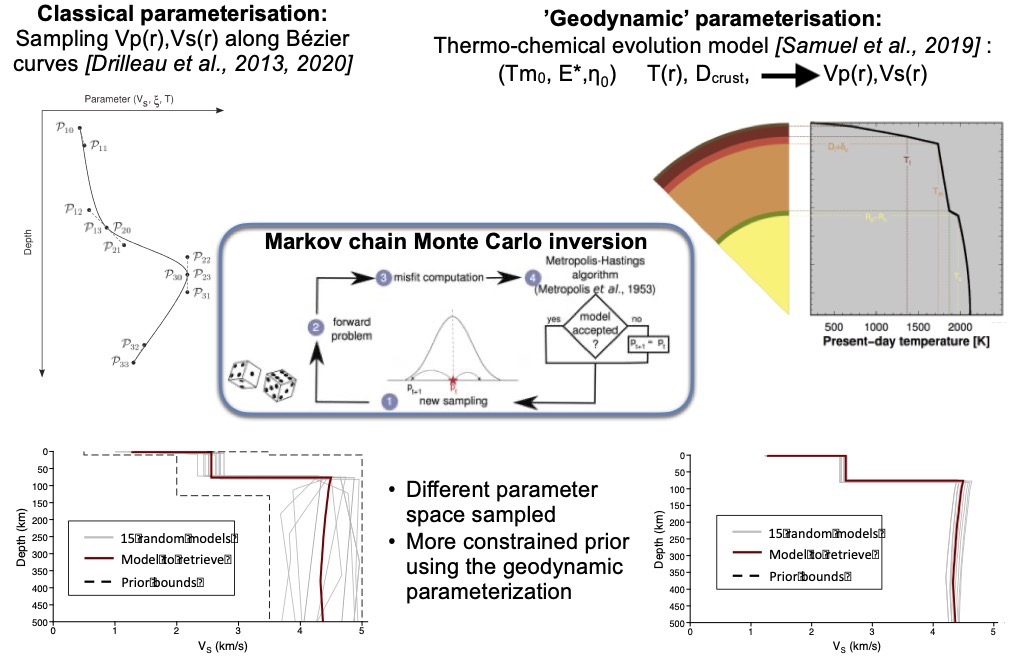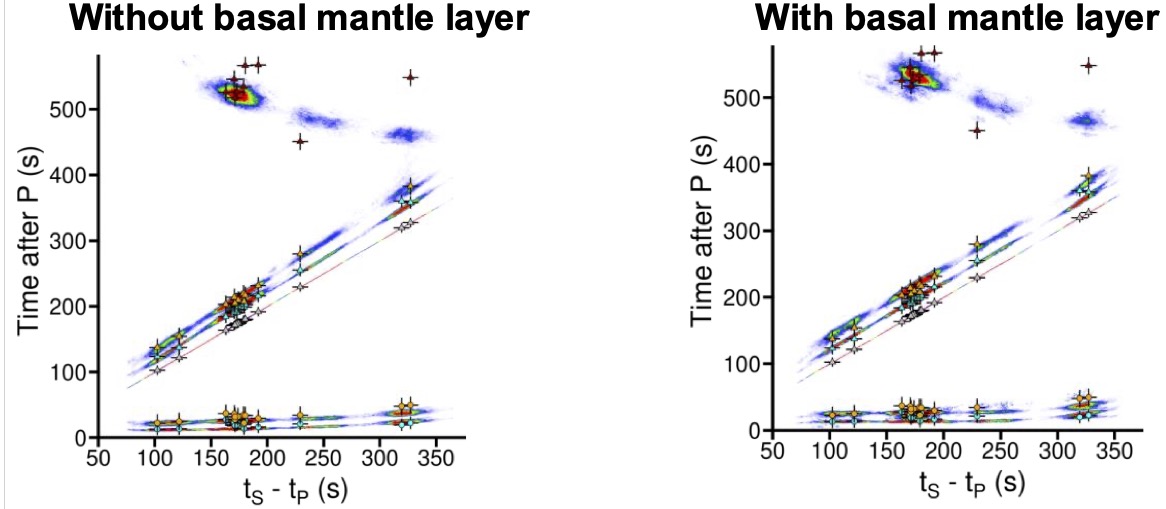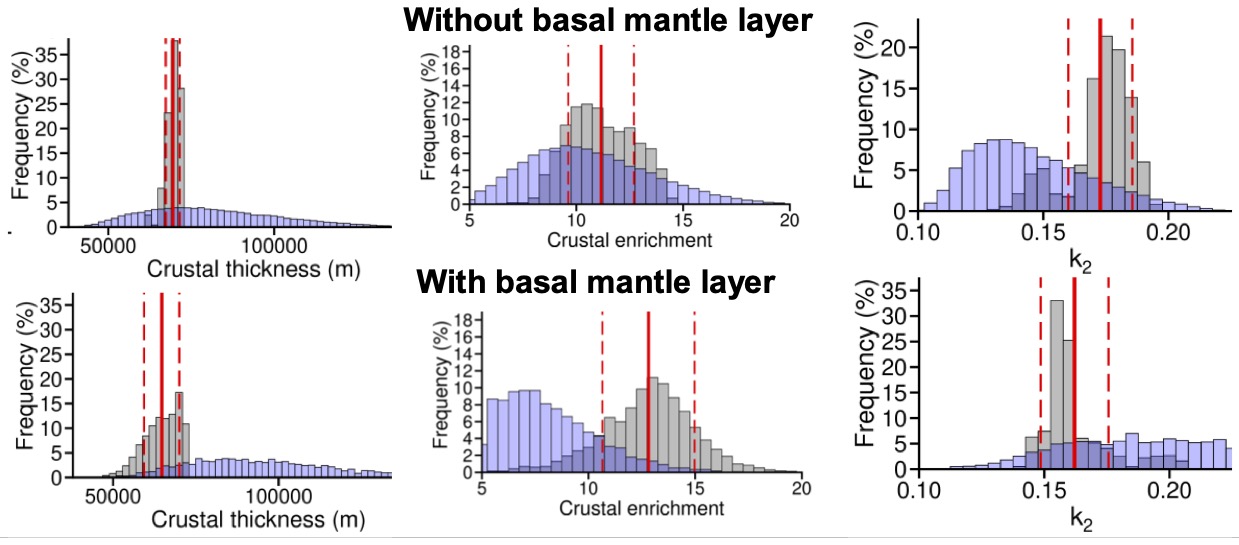Testing the Presence Deep Martian Mantle Layering in the light of InSight Seismic Data
- 1CNRS -IPGP, Planetary and Space Sciences, Paris, France (samuel@ipgp.fr)
- 2Université Paris Cité,Paris, France
- 3ISAE, Toulouse, France
- 4Supaero, Toulouse, France
- 5Colorado School of mines, Golden, USA
- 6Royal observatory of Brussels, Brussels, Belgium
- 7JPL-Caltech, Pasadena, USA
Introduction: The identification of deep reflected phases in the InSight mission seismic recording as core reflected phases have led to the first seismic detection of the Martian core [1]. These results indicated that the core size of Mars spans the higher end of InSight pre-mission estimates, implying a large fraction of Sulfur in the core together with smaller fractions of O, C, and H.
The presence of well-separated silicate and metallic envelopes indicates that Mars experienced an early global magma ocean stage whose crystallisation likely led to the formation of a compositionally distinct layer at the bottom of the mantle [2]. Such a layer is expected to be heavily enriched in heat-producing elements and in iron, leading to long-term stability with little mixing between the layer and the overlying mantle. The presence of this enriched basal layer often yields the development of a molten silicate layer above the core that could act as a deep seismic reflector [3].
Objectives and approach: To test the compatibility of Martian mantle layering with seismic data, we conducted Monte Carlo Markov chain inversions in which the long-term thermo-chemical history of Mars’ main envelopes is embedded into the forward problem (Fig. 1). Contrary to more classical approaches that directly invert for seismic velocities and density along a radial planetary profile, we explore a different and smaller model space that consists in parameters that govern the thermo-chemical evolution of Mars: the planetary initial thermal state, the core size, the mantle rheology, or the crustal enrichment in heat-producing element with respect to the mantle. For each model we evolve the system for 4.5 Gyr.

Figure 1: Schematic representation of a classical [5] (left) and a geodynamic parameterization [4] (used here) to infer Mars’ seismic structure via Monte Carlo Markov chain inversion of seismic data.
This results in thermal structures at present-day that are converted into seismic structures [4]. This approach allows for a more coherent and more constrained profile than in classical inversions (Fig. 1), due to the more informative prior considered, and allows reconstructing the long-term history of the planet. Our inversion approach also considers an enriched silicate layer above the core-mantle boundary and we therefore invert for the layer thickness and for its thermal conductivity. We used the most recent travel time dataset that contains considerably more shallow and deep phases compared to previous studies.
Altogether, this allows us to test the hypothesis of the presence of a molten layer at the top of Mars' core, along with the associated consequences on the interpretation of seismic, geodetic, and geochemical data.
Results: Our inversion results indicate that the presence of a basal mantle layer is at least as compatible with seismic data than a homogeneous Martian structure (Fig. 2).

Figure 2: Data fit for the inversion output considering a basal mantle layer (left) or a homogeneous mantle (right). Warm and cold colors indicate respectively high and small probability densities.

Figure 3: Inversion results without (top) and with (bottom) a mantle stratification. Prior (grey) and posterior (blue) distribution for several inverted parameters. The plain and dashed red lines indicate the posterior mean value and 1-sigma range.
Fig. 3 shows that the basal mantle layer yields a thinner, crust less enriched in heat-producing element than in the case of a homogeneous mantle. It also shows that a basal mantle layer is also compatible with geodetic constraints on k2 values: 0.174±0.008 [7], in good agreement with theoretical predictions [3].
Conclusions: Our new inversion results indicate that the presence of a basal mantle layer is compatible with seismic data. The basal mantle layer stores a significant fraction of heat-producing elements and depletes the rest of the mantle. This reduces shallow mantle heating and melting leading to thinner crusts that are more compatible with receiver functions and gravity data constraints [8]. Finally, the presence of the enriched basal mantle layer is also compatible with the Love number values for Mars [7]. We will present more advanced inversion results using an augmented database that will contain additional phases, including phases that are most sensitive to the deep mantle structure (e.g., Pdiff).
References:
[1] Stähler, S., et al., Science 373, 443–448 (2021)
[2] Elkins-Tanton, L. et al., JGR., doi:10.1029/2005JE002480 (2003)
[3] Samuel, H. et al., JGR, doi:10.1029/2020JE006613 (2021).
[4] Drilleau, M. et al., G. J. Int., 226, 1615-1644 (2021)
[5] Drilleau M., et al., G. J. Int., 195, 1165-1183 (2013)
[6] Khan, A., et al., Science, 373, 434-438 (2021)
[7] Konopliv, A. et al., JGR, 47, doi: 10.1029/2020GL090568 (2020)
[8] Knapmeyer-Endrun, B. et al., Science, 373 (2021)
How to cite: Samuel, H., Drilleau, M., Garcia, R., Huang, Q., Rivoldini, A., Lognonné, P., and Banerdt, B.: Testing the Presence Deep Martian Mantle Layering in the light of InSight Seismic Data, Europlanet Science Congress 2022, Granada, Spain, 18–23 Sep 2022, EPSC2022-297, https://doi.org/10.5194/epsc2022-297, 2022.

